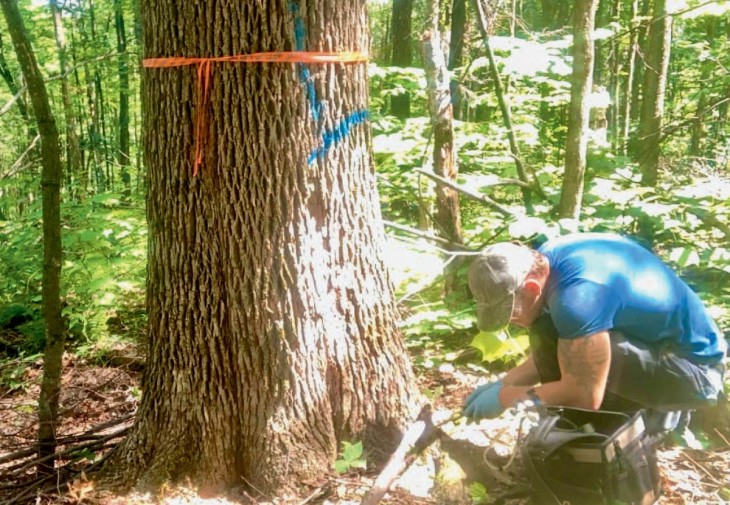
We know that emerald ash borer is going to kill most of the ash trees in our forest, but is there value in chemically treating a few trees – and, if so, which ones? What about the limited flight of the insect – is it possible to protect trees that are a quarter-mile or more from other ash? And is there anything else we can do to help promote a fast ash recovery, assuming EAB “burns out” in our area?
To answer your question about treating ash trees, let me first address your other two questions. Early attempts to prevent the spread of emerald ash borer (EAB) by cutting all the ash trees within a certain radius of an infestation failed – isolating ash does not appear to be a viable strategy. Similarly, lowering the density of ash in your forest by cutting ash trees doesn’t prevent the proliferation of EAB. In fact, studies have shown that ash trees in forests with lower ash densities are actually killed more quickly.
We once believed that EAB would move across our landscape, killing all ash trees and then dying out for lack of food. We now know this is not going to happen. In places that have been infested for decades, EAB persists on the landscape, infesting smaller and smaller trees and killing ash trees as they become large enough to infest (about 1 inch in diameter).
Ash treatment (sometimes called “ash protection”) can be an effective means of keeping individual ash trees alive. While there are several available treatments, the one most experts recommend is a stem injection of emamectin benzoate repeated every 2 to 3 years. Because of the frequency, the duration (trees need to be treated indefinitely), and the cost of ash treatment, this approach is most applicable to a few high-value street and yard trees and isn’t scalable to every ash tree in a forest. That said, some forest managers (myself included) have taken to treating a few ash trees in the woods.
The main ecological value of ash treatment in the woods is in protecting a seed source for future generations of ash. Ideal trees for treatment are mature trees with full crowns and no obvious health concerns. We generally want a mix of male and female ash trees in a given area, with females (distinguishable by their seeds and flowers) slightly preferred. While all ash species can be treated, black ash – which seems to have no resistance to EAB – is of special importance. It makes sense to treat ash trees that are clustered together, both so they can cross-pollinate and so they are easy to access for repeated treatment.
Because we can’t cut our way out of this problem, and we can’t wait for EAB to “burn out,” we have two main hopes – beyond treating individual trees – for the future of ash. The first is in ash’s natural resistance: nearly all regions affected by EAB have reported some “lingering ash” – trees that have survived the initial wave of infestation. Some of these trees have adaptations that make them resistant or resilient to EAB. These adaptations may be passed on to future generations through natural regeneration or through propagation; some researchers are currently working to breed resistant ash. The second source of hope is biocontrols – organisms from EAB’s native range that parasitize or prey on EAB and do not appear, based on rigorous testing, to substantially impact native species. While there is no indication that biocontrols could eradicate EAB, they may be effective at keeping populations of EAB low enough to allow some ash to survive.
While preemptively harvesting ash trees isn’t going to reduce the infestation or the spread of EAB, it can help us attain other important objectives, both for ash and for the forest as a whole.
By cutting quarter-acre groups (the minimum growing space needed for ash regeneration) around ash seed trees or pockets of established ash seedlings, we can promote new generations of ash trees, which may have genetic resistance, or at least resilience, to EAB. These trees could also help maintain ash on our landscape should biocontrols be effective in the future. Any forest management to address EAB should also promote a more diverse and healthy forest and should include retention of some ash trees as seed sources and potential lingering ash.
Even if you don’t plan to cut any trees or to treat any ash, keep in mind that the arrival of EAB will mean many dead trees. If there are ash trees around your home or property, or even ash trees you plan to harvest in the woods, consider cutting them before they become infested, as ash trees become notoriously brittle and dangerous to cut once dead. Ash mortality will also allow opportunities for the regeneration of new trees in the forest’s understory. You can prepare your forest for this regeneration by controlling non-native invasive plants and by protecting native tree seedlings from deer browse.


Discussion *